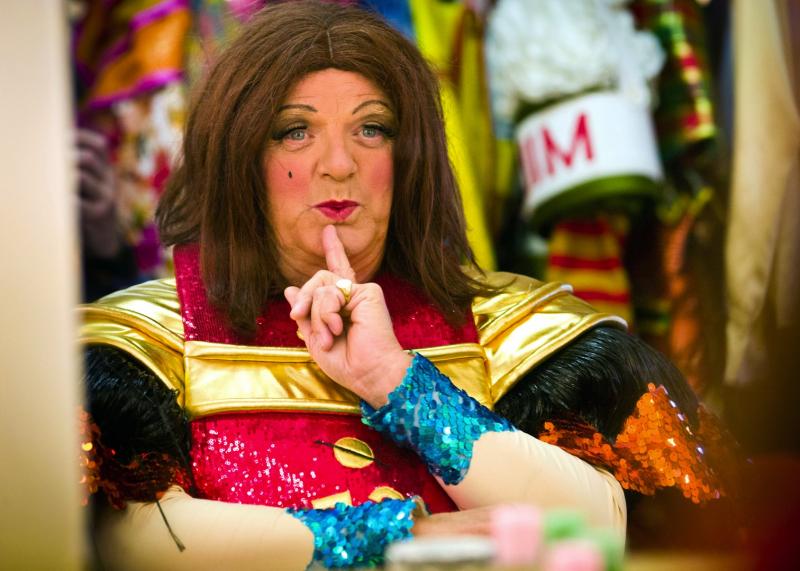Michael Grade's History of the Pantomime Dame, BBC Four | reviews, news & interviews
Michael Grade's History of the Pantomime Dame, BBC Four
Michael Grade's History of the Pantomime Dame, BBC Four
An affectionate history of the queens of misrule

There's nothing like a dame, as any panto fan knows.
Pantomime has a rich history of its own, with commedia dell'arte among its antecedents, and even if there are those who despise its popularity and commercial success, they should remember that David Garrick produced and performed in it, while Joseph Grimaldi was central to its development as comedic theatre. I'm sure this snobbery is something to do with the cross-dressing, in outrageous frocks and OTT make-up, which gives panto an air of the seaside postcard; Grade entered into the spirit of things by dressing up in Dame's garb (pictured as himself, below) and, as more than one contributor noticed, he was a natural playing a woman.
Grade gave a decent overview of panto's origins, and the part played in its development by Garrick, John Rich at Covent Garden and his great rival Augustus Harris at Drury Lane Theatre Royal, just around the corner. Rich was aptly named; he made an enormous success of his productions, and in the mid 18th century panto was raking in 10 times as much as Shakespeare for his theatre.
 But it was Dan Leno - “the model for all Dames since” - who invented the Dame, or something very like the character we know today. An 1861 photograph showed that his Widow Twankey (originally Twankay, a cheap kind of tea) was quite plain in make-up and costume by comparison to today's Dames, but the basic elements of the character - naughty, knowing, queen of misrule - were already there.
But it was Dan Leno - “the model for all Dames since” - who invented the Dame, or something very like the character we know today. An 1861 photograph showed that his Widow Twankey (originally Twankay, a cheap kind of tea) was quite plain in make-up and costume by comparison to today's Dames, but the basic elements of the character - naughty, knowing, queen of misrule - were already there.
Over the years the importance of the role has grown and Grade had good archive material of some great 20th-century Dames - including Terry Scott, Arthur Askey, Douglas Byng, Billy Dainty and Jack Tripp - talking about their craft, and some very knowledgeable talking heads (Gyles Brandreth, Matthew Kelly) on panto's history and significance in our culture.
They all made the point that the audience must always know that the Dame is a man and there was an interesting section about Danny La Rue, a female impersonator, who started playing her as a glamourpuss in sparkling frocks in the famous London Palladium pantos of the 1960s and 70s. Some Dames were not happy about him joining their number because they felt he was too much like a woman - or a heightened drag version of one, at least. It was lovely to see footage of the star-filled Palladium pantos, as sadly the last one was performed there in 1986.
There was a strangely brief contribution from Richard Briers, who told us only that he didn't llike playing the Dame at the height of his TV fame (celebrity casting has been a constant, way back to Garrick), and there were curious omissions - Roy Hudd, once a terrific Dame, a prolific writer of pantos and a noted historian of the form, and Christopher Biggins, a wonderful Dame still donning his false bosoms, I'm glad to say. There was, though, an extended contribution from Berwick Kaler, now in his 34th panto at York Theatre Royal, without doubt one of the greatest Dames of all, who spoke with unalloyed affection for pantomime.
This is perhaps too large a subject to be shoehorned into an hour, but Grade's unbounded enthusiasm and insider anecdotes made it great fun
The future of Arts Journalism
You can stop theartsdesk.com closing!
We urgently need financing to survive. Our fundraising drive has thus far raised £33,000 but we need to reach £100,000 or we will be forced to close. Please contribute here: https://gofund.me/c3f6033d
And if you can forward this information to anyone who might assist, we’d be grateful.

Subscribe to theartsdesk.com
Thank you for continuing to read our work on theartsdesk.com. For unlimited access to every article in its entirety, including our archive of more than 15,000 pieces, we're asking for £5 per month or £40 per year. We feel it's a very good deal, and hope you do too.
To take a subscription now simply click here.
And if you're looking for that extra gift for a friend or family member, why not treat them to a theartsdesk.com gift subscription?
more TV
 Your Friends & Neighbors, Apple TV+ review - in every dream home a heartache
Jon Hamm finds his best role since 'Mad Men'
Your Friends & Neighbors, Apple TV+ review - in every dream home a heartache
Jon Hamm finds his best role since 'Mad Men'
 MobLand, Paramount+ review - more guns, goons and gangsters from Guy Ritchie
High-powered cast impersonates the larcenous Harrigan dynasty
MobLand, Paramount+ review - more guns, goons and gangsters from Guy Ritchie
High-powered cast impersonates the larcenous Harrigan dynasty
 This City is Ours, BBC One review - civil war rocks family cocaine racket
Terrific cast powers Stephen Butchard's Liverpool drug-ring saga
This City is Ours, BBC One review - civil war rocks family cocaine racket
Terrific cast powers Stephen Butchard's Liverpool drug-ring saga
 The Potato Lab, Netflix review - a K-drama with heart and wit
Love among Korean potato-researchers is surprisingly funny and ideal for Janeites
The Potato Lab, Netflix review - a K-drama with heart and wit
Love among Korean potato-researchers is surprisingly funny and ideal for Janeites
 Adolescence, Netflix review - Stephen Graham battles the phantom menace of the internet
How antisocial networks lead to real-life tragedy
Adolescence, Netflix review - Stephen Graham battles the phantom menace of the internet
How antisocial networks lead to real-life tragedy
 Drive to Survive, Season 7, Netflix review - speed, scandal and skulduggery in the pitlane
The F1 documentary series is back on the pace
Drive to Survive, Season 7, Netflix review - speed, scandal and skulduggery in the pitlane
The F1 documentary series is back on the pace
 A Cruel Love: The Ruth Ellis Story, ITV1 review - powerful dramatisation of the 1955 case that shocked the public
Lucy Boynton excels as the last woman to be executed in Britain
A Cruel Love: The Ruth Ellis Story, ITV1 review - powerful dramatisation of the 1955 case that shocked the public
Lucy Boynton excels as the last woman to be executed in Britain
 Towards Zero, BBC One review - more entertaining parlour game than crime thriller
The latest Agatha Christie adaptation is well cast and lavishly done but a tad too sedate
Towards Zero, BBC One review - more entertaining parlour game than crime thriller
The latest Agatha Christie adaptation is well cast and lavishly done but a tad too sedate
 Bergerac, U&Drama review - the Jersey 'tec is born again after 34 years
Damien Molony boldly follows in the hallowed footsteps of John Nettles
Bergerac, U&Drama review - the Jersey 'tec is born again after 34 years
Damien Molony boldly follows in the hallowed footsteps of John Nettles
 A Thousand Blows, Disney+ review - Peaky Blinders comes to Ripper Street?
The prolific Steven Knight takes us back to a squalid Victorian London
A Thousand Blows, Disney+ review - Peaky Blinders comes to Ripper Street?
The prolific Steven Knight takes us back to a squalid Victorian London
 Zero Day, Netflix review - can ex-President Robert De Niro save the Land of the Free?
Panic and paranoia run amok as cyber-hackers wreak havoc
Zero Day, Netflix review - can ex-President Robert De Niro save the Land of the Free?
Panic and paranoia run amok as cyber-hackers wreak havoc
 The White Lotus, Series 3, Sky Atlantic review - hit formula with few surprises but a new bewitching soundtrack
Thailand hosts the latest bout of Mike White's satirical takedown of the rich and privileged
The White Lotus, Series 3, Sky Atlantic review - hit formula with few surprises but a new bewitching soundtrack
Thailand hosts the latest bout of Mike White's satirical takedown of the rich and privileged

Add comment